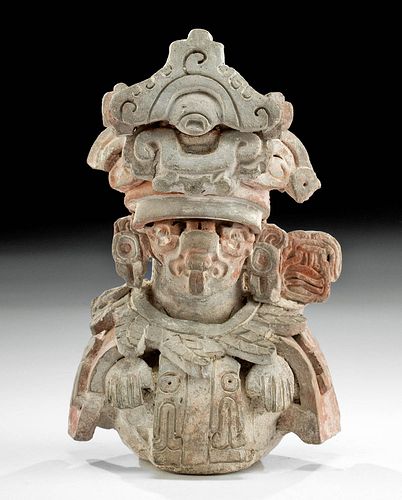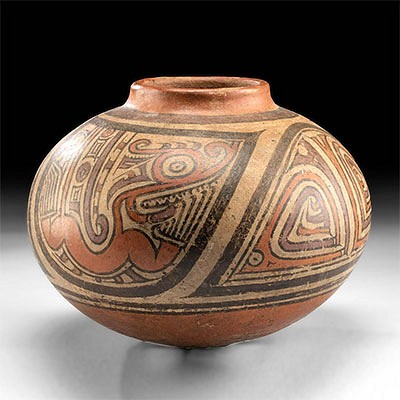Zapotec Pottery Incensario of God Cocijo
Lot 138a
About Seller
Artemis Fine Arts
686 S Taylor Ave, Ste 106
Louisville, CO 80027
United States
Selling antiquities, ancient and ethnographic art online since 1993, Artemis Gallery specializes in Classical Antiquities (Egyptian, Greek, Roman, Near Eastern), Asian, Pre-Columbian, African / Tribal / Oceanographic art. Our extensive inventory includes pottery, stone, metal, wood, glass and textil...Read more
Categories
Estimate:
$800 - $1,200
Absentee vs Live bid
Two ways to bid:
- Leave a max absentee bid and the platform will bid on your behalf up to your maximum bid during the live auction.
- Bid live during the auction and your bids will be submitted real-time to the auctioneer.
Bid Increments
| Price | Bid Increment |
|---|---|
| $0 | $25 |
| $300 | $50 |
| $1,000 | $100 |
| $2,000 | $250 |
| $5,000 | $500 |
| $10,000 | $1,000 |
| $20,000 | $2,500 |
| $50,000 | $5,000 |
| $100,000 | $10,000 |
| $200,000 | $20,000 |
About Auction
By Artemis Fine Arts
Apr 15, 2021
Set Reminder
2021-04-15 10:00:00
2021-04-15 10:00:00
America/New_York
Bidsquare
Bidsquare : VARIETY SALE | Ancient & Ethnographic Art
https://www.bidsquare.com/auctions/artemis-gallery/variety-sale-ancient-ethnographic-art-6811
Featuring classical antiquities, ancient and ethnographic art from cultures encompassing the globe. Egyptian, Greek, Roman, Etruscan, Near Eastern, Asian, Pre-Columbian, Native American, African / Tribal, Oceanic, Spanish Colonial, Russian, Fossils, Fine Art, more! Artemis Fine Arts info@artemisfinearts.com
Featuring classical antiquities, ancient and ethnographic art from cultures encompassing the globe. Egyptian, Greek, Roman, Etruscan, Near Eastern, Asian, Pre-Columbian, Native American, African / Tribal, Oceanic, Spanish Colonial, Russian, Fossils, Fine Art, more! Artemis Fine Arts info@artemisfinearts.com
- Lot Description
Pre-Columbian, Mexico, Oaxaca, Zapotec culture, Monte Alban, ca. 100 BCE to 200 CE. An impressive hand-built pottery incensario depicting the bust of Cocijo (also Cociyo, literally translated as "lightning" in the Zapotec language), the Zapotec god of rain, thunder, and lightning, embellished with red and black glaze. Heavily adorned, the ancient figure wears an elaborate chestpiece comprised of two rectangular shoulder flaps and a central banner, all bearing a glyph known as the hairpin glyph, which is associated with water and translates to moist. An intricate collar necklace of six feathers hangs from the deity's neck, and a sizable headdress bearing the glyph "C" meaning rain, the symbol of Cocijo, sits atop his head. On his face he wears the distinctive 'buccal' nose/face mask, with a wide, blunt snout and a serpent-like, split tongue protruding from his mouth. A pair of large earrings flanks his stylized visage, and each displays what appears to be an upside-down hairpin glyph. An additional glyph, which likely represents water, sits on his left shoulder. Size: 3.5" W x 5.5" H (8.9 cm x 14 cm)
Many cultures at this time were producing ceremonial incensarios (censers), but Monte Alban's in particular are often so anthropomorphized, that from the front they can be difficult to distinguish from sculpture. Scholars posit that such figural censers were created to honor deceased elite members of society.
Provenance: private Burlington, North Carolina, USA collection; ex-A to Z Auctions, Burlington, North Carolina, USA; ex-James Pratley estate, Galveston, Texas, USA, acquired before 2000
All items legal to buy/sell under U.S. Statute covering cultural patrimony Code 2600, CHAPTER 14, and are guaranteed to be as described or your money back.
A Certificate of Authenticity will accompany all winning bids.
We ship worldwide and handle all shipping in-house for your convenience.
#163542Chip to rim. Loss to proper right shoulder flap. Repair and restoration to proper left side of headdress. Expected nicks and abrasions commensurate with age. Otherwise, excellent with lovely earthen deposits and remaining pigments.Condition
- Shipping Info
-
All shipping is handled in-house for your convenience. Your invoice from Artemis Gallery will include shipping calculation instructions. If in doubt, please inquire BEFORE bidding for estimated shipping costs for individual items.
-
- Buyer's Premium



 EUR
EUR CAD
CAD AUD
AUD GBP
GBP MXN
MXN HKD
HKD CNY
CNY MYR
MYR SEK
SEK SGD
SGD CHF
CHF THB
THB














